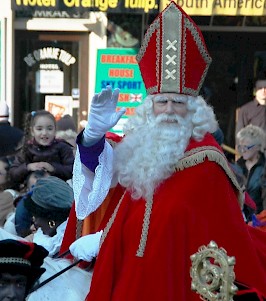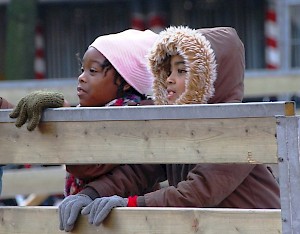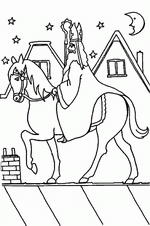Today's folklore
Nicholas of Myra: early Christian bishop, who was in the Middle Ages venerated as patron of sailors and protector of blessed marriages (Saint Nicholas). As Sinterklaas, he remains a characteristic figure in Dutch folklore. He is also the historical figure behind Santa Claus.

Returning to the Dutch Sinterklaas today, we can see that he has retained many characteristics of pre-Capitalist thought. In general, he teaches that children must give to people who are less fortunate, without expecting something in return. The good holy man sets the example. Of course, this does not mean that children do not request the most expensive presents, and it must be noted that millions are spend on Sinterklaas gifts, but many parents (or hired actors) explain that the feast is more about giving than about receiving.
The celebrations start in November, when Sinterklaas arrives in a port with a large ship with presents, after a long voyage - said to be from Spain. After all, for centuries, the city of Bari, where Nicholas lies buried, was part of the Spanish dominions. Often, the mayor receives Sinterklaas, who now starts a procession into town.

He is accompanied by a helper, who is called Zwarte Piet, 'black Pete'. Although he has received his present looks (as a Moorish page) in the nineteenth century, this is probably another relic from pre-Christian times, when a dwarf-like demon, defeated by the good god Wodan, was forced to perform good deeds for humankind. He is usually called Krampus. (According to some scholars, Black Pete is in fact derived from the black ravens that were Wodan's friends, but this theory appears to be ill-founded.)

Over the centuries, the Krampus demon has developed in various directions.
- When Saint Nicholas visits towns in northern France, his companion is a red-haired wild man (père Fouettard).
- In Flanders, children often given him a beer to help him with his hard work.
- In the Netherlands, he has received a Moorish dress, and today, now that many colored people from Surinam are living in the Netherlands, there is some debate whether there is a racist aspect to Zwarte Piet. Often, green, yellow, red, and blue Peters are added as an acceptable compromise.
After his tour through the city, which is usually broadcasted on TV, Sinterklaas disappears, but in the first week of December, he visits schools and families. (There are special companies where you can hire a Sinterklaas and there is a society that trains actors.) Children sing special songs, some of which are very old and incomprehensible. Later, they receive a pastoral word from the bishop, who encourages them to be sweet children and censures bad behavior.

On the fifth of December, children will place their shoe somewhere near the hearth (this creates problems in modern houses), and early in the morning of the sixth, they will find that Sinterklaas has visited their home. Among the typical presents are oranges, sweets, and chocolate bars in the shape of letters. And of course some of the presents the children have requested.
It is usually a big disappointment when the children, about six years old, are told that Sinterklaas does not really exist. Learning the sad truth is, however, also a rite de passage. From now on, the children are, in at least one aspect, treated as grown-up people, and invited to celebrate the pakjesavond, "presents evening", during which adults exchange gifts. Usually, little poems are added, in which Sinterklaas ridicules odd habits. In this aspect, Saint Nicholas is still a bishop who guides his flock.